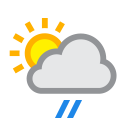In North Korea, the severe seasonal changes are linked with national commemorative events, which include agricultural, political, and cultural activities. Below is a summary of the climatic characteristics and main seasonal events for each season.
Spring (March to May)
Climatic Characteristics
- Temperature: Average temperatures gradually rise from 0-10°C in March to 10-18°C in April and 15-23°C in May.
- Precipitation: Low in March, increasing in April and May (especially in May).
- Features: Soil moisture recovery due to snowmelt and strong spring winds.
Major Events and Culture
| Month |
Event |
Description and Relation to Climate |
| March |
Spring Tillage Preparation |
Fields that were frozen during winter begin to thaw, and preparations for rice planting and tilling start. |
| April |
Army Day (4/25) |
A military parade celebrating the establishment of the Korean People's Army. Outdoor events take place in mild weather. |
| April |
Sun Day (4/15) |
The birthday of Kim Il-sung. Flower altars are set up, and memorial gatherings are held, using spring flowers for decoration. |
| May |
May Day (5/1) |
Large gatherings and parades on International Workers' Day. Celebratory events take place in urban areas surrounded by fresh greenery. |
Summer (June to August)
Climatic Characteristics
- Temperature: Ranges from 20-28°C in June, peaking at 25-33°C in July and August, with high humidity.
- Precipitation: Long rainy season equivalent to the monsoon begins in mid-June, with frequent localized heavy rain and thunderstorms after July.
- Features: High humidity, thunderstorms, and increased risk of heatstroke.
Major Events and Culture
| Month |
Event |
Description and Relation to Climate |
| July |
Armistice Day (7/27) |
Commemorates the signing of the Korean War armistice. Memorial gatherings and military parades are conducted utilizing the summer weather. |
| August |
Liberation Day (8/15) |
Celebrates liberation from Japan. Fireworks and ceremonies are held outdoors, but caution is needed due to potential typhoon impacts. |
| August |
Mass Games (Arirang Art Festival) |
Held at a stadium near the Tower of the Juche Idea in Pyongyang. Large-scale performances are conducted on sunny days. |
Autumn (September to November)
Climatic Characteristics
- Temperature: Drops sharply from 20-28°C in September to 10-20°C in October and 0-10°C in November.
- Precipitation: September still experiences lingering heat and typhoon impacts, while the weather becomes dry and clear after October.
- Features: Harvest season suitable for drying crops, with fewer autumn leaves but characterized by clear air.
Major Events and Culture
| Month |
Event |
Description and Relation to Climate |
| September |
Chuseok (around August 15 of the lunar calendar) |
Similar to South Korea's harvest festival. Under clear skies, ancestral worship and family gatherings are held. |
| October |
Korean Workers' Party Foundation Day (10/10) |
Celebrates the founding of the Workers' Party of Korea. Political meetings and cultural performances take place in mild weather. |
| November |
Autumn Harvest Festival |
Nationwide celebration for the harvest of rice and grains. Outdoor events proceed smoothly in dry weather. |
Winter (December to February)
Climatic Characteristics
- Temperature: Extremely cold, ranging from -5 to 5°C in December, -10 to 0°C in January, and -8 to 2°C in February.
- Precipitation: Dry season with light snowfall concentrated in coastal areas, and blizzards to be cautious of in inland areas.
- Features: Radiative cooling leads to colder mornings and evenings, making outdoor activities challenging.
Major Events and Culture
| Month |
Event |
Description and Relation to Climate |
| January |
New Year (1/1) |
New Year's celebrations. Fireworks and celebratory gatherings are held in the capital despite harsh cold. |
| February |
Kim Jong Il Day (2/16) |
The birthday of Kim Jong Il. Mass games and commemorative gatherings may take place in snowy weather. |
| February |
Snow Sculpture Festival (held regionally) |
A snow sculpture competition. Held in regions with good snow quality as part of winter tourism promotion. |
Summary of Seasonal Events and Climate Relationship
| Season |
Climatic Characteristics |
Example Major Events |
| Spring |
Rising temperatures, increased precipitation, strong spring winds |
Army Day, Sun Day, May Day |
| Summer |
Hot and humid, monsoon and thunderstorms, risk of heatstroke |
Armistice Day, Liberation Day, Arirang Mass Games |
| Autumn |
Dry, clear skies post-typhoon |
Chuseok, Korean Workers' Party Foundation Day, Autumn Harvest Festival |
| Winter |
Extreme cold, dry, radiative cooling |
New Year, Kim Jong Il Day, Snow Sculpture Festival |
Additional Notes
- Many events are centered around state-led commemorative days, exhibiting strong political and ideological colors.
- Traditional events closely linked with agriculture are held in accordance with the timing of spring tillage and autumn harvest.
- Lunar calendar-based events (Chuseok, Lunar New Year) share a common cultural background with South Korea.
- Outdoor winter events are held considering climatic conditions and are limited to certain regions.
In North Korea, severe climate and national commemorative events integrate to unfold seasonal agricultural and cultural activities.
 Light rain shower
Light rain shower